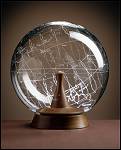Spherical dials

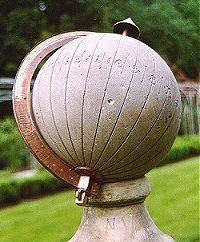 Spherical dials belong to the group of pole-style dials. The 'pole-style' here is the axis - not always visible - of the sphere, parallel to the earth's axis. Time is being read from an equatorial hour scale, which thus is perpendicular to the pole-style. The spherical dial is attractive, being the closest model of the relationship between earth and sun.
Spherical dials belong to the group of pole-style dials. The 'pole-style' here is the axis - not always visible - of the sphere, parallel to the earth's axis. Time is being read from an equatorial hour scale, which thus is perpendicular to the pole-style. The spherical dial is attractive, being the closest model of the relationship between earth and sun.
There are in fact two quite different types of spherical dials. One has an arch-shaped gnomon, the meridian arch, which rotates around the pole-style. When the arch is turned so that the shadow is as thin as possible, it just points towards the sun. At that point the time is being read from the equatorial time scale. It thus is an interactive device, just like the analemmatic dial: action is required to find out the time.
This dial type can be considered as the 'inverse' of the well-known armillary sphere. There the time is read where the shadow of the pole-style hits the hour scale; here one determines which point of the hour scale would just cast its shadow on the pole-style in case the sphere were transparent. The meridian arch is used as an accessory to overcome the opaqueness of the sphere.
The idea of transparency has unfolded very elegantly in the glass sphere by Daniel Wenger. Actually, this is not a pole-style dial but a nodal dial, which enables simultaneous reading of time and date.
A simpler way of 'inverting' the armillary sphere has been obtained by perforating the sun-facing hour band. The page on equatorial dials has several examples.
The other type of spherical dial is the shadow sphere or terrella. It lacks moving parts, as the sphere is its own gnomon. In this case, time is read at the terminator, the edge of the sunlit part of the sphere. The time scale is rotated 90° with respect to the above dial type. Hence, the 6-hr mark is in the meridian. As the terminator shows up at both sides of the sphere, one has to find out oneself whether it's 6 am or 6 pm, for instance. The reading is not very accurate, as the terminator is not a very sharp line. Judging from the Enschede dial shown below, the accuracy may be some 15 minutes.
Both types of spherical dials can be provided with a world map. It will show where it's daytime and nighttime, where it's dawning and where the sun is just setting. The place where the sun is right overhead can be located using a tool that is positioned perpendicular to the globe's surface. The sphere in Maaseik is an example.
|
Spherical dials with meridian arch |
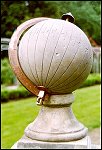 |
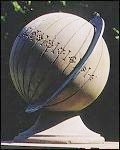 |
|
|
Verhildersum Manor, Leens
|
Private garden
Groningen
|
|
|
|
Shadow spheres |
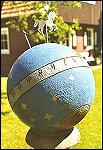 |
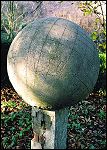 |
|
|
Private garden
Enschede
|
Convent garden
Maaseik (Belgium)
|
|
|

 Spherical dials belong to the group of pole-style dials. The 'pole-style' here is the axis - not always visible - of the sphere, parallel to the earth's axis. Time is being read from an equatorial hour scale, which thus is perpendicular to the pole-style. The spherical dial is attractive, being the closest model of the relationship between earth and sun.
Spherical dials belong to the group of pole-style dials. The 'pole-style' here is the axis - not always visible - of the sphere, parallel to the earth's axis. Time is being read from an equatorial hour scale, which thus is perpendicular to the pole-style. The spherical dial is attractive, being the closest model of the relationship between earth and sun.



